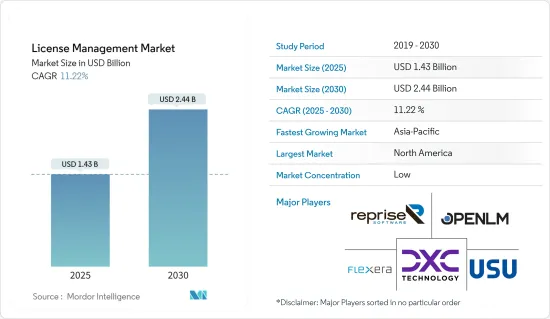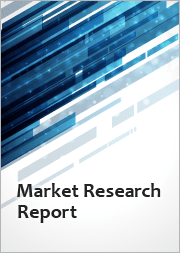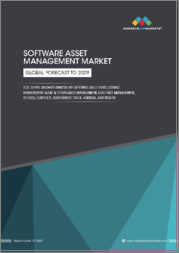
|
시장보고서
상품코드
1690782
세계의 라이선스 관리 시장 : 점유율 분석, 산업 동향 및 통계, 성장 예측(2025-2030년)License Management - Market Share Analysis, Industry Trends & Statistics, Growth Forecasts (2025 - 2030) |
||||||
세계의 라이선스 관리 시장 규모는 2025년 14억 3,000만 달러로 추정되며, 예측 기간 중(2025-2030년) CAGR 11.22%로 확대되어, 2030년에는 24억 4,000만 달러에 이를 것으로 예측됩니다.

시장 성장을 가속하는 주요 요인으로는 IT 인프라에 대한 투자 증가, 기업 전반에 걸친 디지털화의 급속한 도입 등이 있습니다. 또한 클라우드 기술의 발전과 단일 라이선스를 관리하는 도구에 대한 수요가 증가함에 따라 소프트웨어 투자 최적화가 기대되고 있습니다. 이러한 도구는 비용을 절감하고, 전사적인 소프트웨어 사용을 촉진하며, 개발자의 라이선스 조항에 대한 컴플라이언스를 보장하기 위한 것입니다.
이 시장은 디지털 툴과 플랫폼 채용 증가, 산업을 넘어선 컴플라이언스를 효율적으로 충족시킬 필요성 증가, 소프트웨어 지출을 극대화할 필요성 증가 등 여러 요인에 견인되어 큰 성장을 기록하고 있습니다.
또한 기업은 기술 투자를 재조정하고 있습니다. 이 재구성에는 소프트웨어 투자 최적화, 기술 플랫폼 간소화, 종합적인 소프트웨어 공급업체 계약 검토 실시, 가장 유익한 소프트웨어 라이선스 모델 식별 등의 조치가 포함됩니다. 이러한 상황에서는 라이선스 관리 솔루션과 서비스가 매우 중요하며 마이그레이션을 용이하게 하기 위한 중요한 통찰과 권장 사항을 제공합니다.
조직은 규모와 크기에 관계없이 IT 서비스 및 용도 관리를 점점 더 우선시하고 있습니다. 그 결과 기업은 IT 인프라 업그레이드에 많은 투자를 하고 있으며, 향상된 기능과 성능을 바탕으로 레거시 시스템에서 전환하고 있습니다.
매일 새로운 기술이 등장하는 상황에서는 기업이 소프트웨어 사용에 대한 정보를 항상 얻는 것이 매우 중요합니다. 소프트웨어 라이선스 관리는 항상 어려움을 겪고 있지만 오늘날 기술 중심의 환경에서는 복잡성이 커지고 있습니다. 따라서 조직은 중복 라이선스를 제거하고 과도한 라이선스를 피하고 균형 잡힌 지출을 보장함으로써 비용 절감을 우선해야합니다. 이러한 개발로 라이선스 관리 솔루션에 대한 수요가 더욱 커지고 있습니다.
규제 불확실성은 시장 성장 연구에 큰 제약이 되고 있습니다. 세계적으로 통일된 기준이 없고, 지역마다 규제가 변화하고 있기 때문에 다양한 시장에서 효과적인 라이선스 관리 솔루션을 전개하려는 기업에 있어서 과제가 되고 있습니다.
유행 후, 각 업계의 기업은 디지털 변환에 집중하고 디지털 플랫폼과 도구의 대폭적인 도입으로 이어졌습니다. 기업이 디지털 전환 여행에 나서면서 소프트웨어 포트폴리오의 확대와 다양화가 점점 더 진행되고 있습니다. 이러한 디지털 실적가 확대됨에 따라 견고한 라이선스 관리 솔루션에 대한 필요성이 커지고 있으며, 기업은 보다 효율적이고 비용 효율적인 업무로 향하고 있습니다.
라이선스 관리 시장 동향
소프트웨어 컴포넌트 부문이 큰 시장 점유율을 차지할 전망
- 기업이 소프트웨어 자산을 효율적으로 관리할 필요성이 증가함에 따라 소프트웨어 컴포넌트 부문은 큰 성장을 기록할 것으로 예상됩니다. 이 부문은 기업이 라이선스 계약을 준수하고, 비용을 관리하고, 소프트웨어 사용을 최적화하고, 라이선스 위반으로 인한 처벌을 피할 수 있도록 지원하는 솔루션에 중점을 둡니다. 클라우드 서비스, 구독 기반 라이선싱, 소프트웨어 사용 복잡성 등의 동향이 증가함에 따라 소프트웨어 중심 라이선스 관리 솔루션에 대한 수요가 더욱 커지고 있습니다.
- 다양한 산업 분야에서 조직은 점차 업무를 자동화하고 고급 소프트웨어 도구를 채택하고 있습니다. 예를 들어 비즈니스 서비스 회사인 The Innovation Group이 2023년에 실시한 조사에서는 관리직의 약 50%가 자사가 디지털 변혁의 한가운데에 있다고 응답하고 있다는 것이 밝혀졌습니다. 또한 약 27%가 이미 변환을 완료했다고 응답했습니다. 주목할만한 것은 디지털 변환에 착수하지 않았고 예정도 없다고 응답한 기업은 불과 5%였습니다.
- 자동화가 보급됨에 따라 소프트웨어 라이선스 수요가 급증하고 관리가 복잡해지고 있습니다. 자동화된 라이선스 관리 도구는 소프트웨어 자산을 효율적으로 추적하여 최적의 사용을 보장합니다. 기업이 소프트웨어 포트폴리오를 확대하는 동안 수작업으로 라이선스를 관리하는 것이 어려움을 겪고 있습니다. 자동화를 도입하면 소프트웨어 사용을 간소화하고 비용을 최적화하며 낭비를 줄일 수 있습니다.
- 소프트웨어 공급업체의 빈번한 라이선스 감사로 기업에 대한 감시의 눈은 엄격해지고 있습니다. 소프트웨어의 부적절한 사용으로 인한 처벌을 피하기 위해 이러한 컴플라이언스의 추진은 강력한 라이선스 관리 시스템 수요에 박차를 가하고 있습니다. 기업은 감사 대응을 보장하는 솔루션을 적극적으로 추구하고 예기치 않은 금전적 처벌을 피하려고 노력하고 있습니다.
- 컴플라이언스 위반 비용이 증가하고 감사가 더 자주 발생함에 따라 이러한 프로세스를 간소화하고 재무 위험과 운영 부담을 줄이는 소프트웨어의 가치가 드러납니다.
- 클라우드 컴퓨팅은 소프트웨어 라이선싱에 혁명을 가져왔습니다. 예를 들어, Flexera Software의 보고에 따르면 2024년에는 기업의 80%가 퍼블릭 클라우드의 요구에 Microsoft Azure를 이용하게 된다고 합니다. AWS, Microsoft Azure, Google Cloud와 같은 하이퍼스케일러는 전 세계 클라우드 컴퓨팅을 선도하고 있습니다.
큰 성장이 예상되는 아시아태평양
- 소프트웨어 라이선스 최적화 모범 사례를 도입하면 라이선스 사용 부족, 사용 과다, 라이선스 규정 준수 위반 또는 공급업체의 고액 위약금을 초래할 수 있는 선반 웨어를 크게 줄일 수 있으며 기업의 소프트웨어 지출을 약 25% 절약할 수 있습니다. 동시에 기업의 소프트웨어 공급업체와 지능형 장치 제조업체는 유연한 라이선스 구현을 게을리하여 돈을 테이블 위에 놓습니다. APAC의 기업 및 용도 제조업체는 용도 사용 관리가 가져오는 큰 경쟁 우위를 점점 더 잘 이해하고 있습니다.
- 중국 정부는 '중화인민공화국 대외무역법' 및 '중화인민공화국 기술 수출입 관리 조례'의 관련 법규에 따라 수출이 제한되거나 금지된 기술에 대한 종합적인 관리 조치를 실시했습니다. 또한 외국과 기술무역을 하는 영리기업에 대하여 대응하는 관리기술 카탈로그와 관리조치를 책정하여 라이선싱 관리를 하고 있습니다.
- 인도에서는 2023-24년 경제조사에서 영세 및 중소기업(MSME)의 허가, 검사, 컴플라이언스 요건을 완화할 필요성을 강조하였습니다. 도시 개발 관리 및 규정 준수 개혁은 비즈니스 환경을 크게 개선하고 경제 성장을 극복할 수 있습니다.
- 싱가포르에서는 2024년 7월, 싱가포르 금융관리국(MAS)이 결제 서비스 제공업체의 라이선싱에 관한 가이드라인(PS-G01)의 갱신판을 공표해, 2024년 8월에 발효했습니다. 가이드라인의 개정은 싱가포르 결제서비스법(Payment Services Act 2019 of Singapore)에 근거한 결제서비스 제공업체의 라이선싱 프로세스의 명확화, 신청심사의 합리화, 강화를 목적으로 하고 있습니다. 이로 인해 BFSI 부문 시장 수요가 높아질 것으로 기대됩니다.
- 많은 세계 기업들이 R&D 기지로 아시아태평양에 점차 투자하고 있습니다. 예를 들어, 미국에 본사를 둔 Flexella Software는 APAC 지역에서 여러 해 동안 확장 계획을 지속하고 성장의 여지를 제공합니다. Flexella가 APAC 클라우드로 진출함에 따라 ANZ(호주 및 뉴질랜드)와 APAC에서 공급업체와 관계가 있는 기업은 특정 거버넌스와 주권 요구 사항을 충족하면서 Flexella가 제공하는 모든 서비스를 최대한 활용할 수 있습니다.
- 또한 Flexella Software에 따르면 164억 달러의 경제적 가치를 가진 비정규 소프트웨어의 대부분은 아시아태평양을 기반으로 합니다. 다양한 조사에 따르면 아시아태평양(특히 인도, 베트남, 인도네시아, 중국 등)은 비정규 소프트웨어 사용에 있어 최고입니다. 비정규 소프트웨어의 상업적 가치는 지속적으로 상승하고 있습니다.
라이선스 관리 산업 개요
라이선스 관리 시장에는 USU Software AG, DXC Technology Co., Flexera Software LLC, Oracle Corporation, Thales Group, ServiceNow Inc. 등 라이선스 관리 소프트웨어 및 서비스를 제공하는 국내외 기업이 다수 참여하고 있습니다. 각 회사는 이 시장에서 선진적인 솔루션을 개발 및 출시하기 위해 타사와 파트너십을 맺고 있습니다. 따라서 시장에서는 많은 투자가 이루어지고 경쟁이 치열해지고 있습니다.
각 회사는 경쟁 우위를 확보하고 시장에서 경쟁력을 유지하고 고객을 유지하기 위해 첨단 기술을 개발하여 시장 내 적대 관계가 치열 해지고 있습니다. 소프트웨어의 제공과 기능성에 대한 지속적인 혁신은 벤더들에게 차별화 우위를 가져와 경쟁사 간의 적대관계를 격화시킵니다.
전반적으로 경쟁 기업간 경쟁 관계의 치열성은 조사 대상 시장에서 높으며 예측 기간 동안도 마찬가지입니다.
기타 혜택
- 엑셀 형식 시장 예측(ME) 시트
- 3개월간의 애널리스트 서포트
목차
제1장 서론
- 조사의 전제조건과 시장 정의
- 조사 범위
제2장 조사 방법
제3장 주요 요약
제4장 시장 인사이트
- 시장 개요
- 업계의 매력도 - Porter's Five Forces 분석
- 공급기업의 협상력
- 구매자의 협상력
- 신규 참가업체의 위협
- 대체품의 위협
- 경쟁 기업간 경쟁 관계의 강도
- 시장에 대한 COVID-19의 영향 평가
제5장 시장 역학
- 시장 성장 촉진요인
- 소프트웨어 투자 최적화 요구 증가
- 조직에서의 감사 대응에 대한 요구 증가
- 시장 성장 억제요인
- 불투명한 규제 기준과 프레임워크
- 시장 기회
제6장 시장 세분화
- 컴포넌트별
- 소프트웨어
- 서비스별
- 전개별
- 온프레미스
- 클라우드
- 용도별(정성 동향 분석)
- 감사 서비스
- 자문 서비스
- 컴플라이언스 관리
- 라이선스 인타이틀먼트 및 최적화
- 운영 및 분석
- 기타 용도
- 최종 사용자별
- BFSI
- 헬스케어 및 생명과학
- IT 및 통신
- 미디어 및 엔터테인먼트
- 기타 최종 사용자
- 지역별
- 북미
- 유럽
- 아시아
- 호주 및 뉴질랜드
- 라틴아메리카
- 중동 및 아프리카
제7장 경쟁 구도
- 기업 프로파일
- USU Software AG
- OpenLM Ltd
- DXC Technology Co.
- Flexera Software LLC
- Reprise Software Inc.
- License Dashboard
- Oracle Corporation
- Quest Software Inc.
- Thales Group
- ServiceNow Inc.
제8장 투자 분석
제9장 시장의 미래
JHS 25.04.09The License Management Market size is estimated at USD 1.43 billion in 2025, and is expected to reach USD 2.44 billion by 2030, at a CAGR of 11.22% during the forecast period (2025-2030).

Key drivers fueling market growth include heightened investments in IT infrastructure and rapid digitalization adoption across businesses. Furthermore, advancements in cloud technology, coupled with surging demand for tools that manage single licenses, promise to optimize software investments. These tools aim to cut costs, boost software usage across the company, and ensure compliance with the developer's licensing terms.
The market is registering significant growth, led by several factors, including the rising adoption of digital tools and platforms, the growing need to meet compliance across industry verticals efficiently, and the rising need to maximize software expenditures.
Furthermore, businesses are recalibrating their technological investments. This realignment includes actions like optimizing software investments, streamlining technology platforms, conducting comprehensive software vendor contract reviews, and pinpointing the most beneficial software licensing models. In this context, license management solutions and services are crucial, offering vital insights and recommendations to ease the transition.
Organizations, both large and small, are increasingly prioritizing the management of IT services and applications for both immediate and future strategic decisions. As a result, enterprises heavily invest in upgrading their IT infrastructure, moving away from legacy systems based on enhanced features and capabilities.
In a landscape where new technologies emerge almost daily, it's crucial for organizations to stay informed about their software usage. While managing software licenses has always posed challenges, the complexities have intensified in today's tech-driven environment. Therefore, organizations must prioritize cost savings by eliminating duplicate licenses, avoiding over-licensing, and ensuring balanced spending. Such developments are further driving the demand for license management solutions.
Regulatory uncertainty is a significant constraint on the market's growth studied. The absence of uniform global standards and shifting regional regulations pose challenges for companies striving to deploy effective license management solutions in diverse markets.
Post-pandemic, businesses across industries increased focus on digital transformation, resulting in substantial adoption of digital platforms and tools. As enterprises embark on digital transformation journeys, they increasingly expand and diversify their software portfolios. With this growing digital footprint, the need for robust license management solutions intensifies, steering organizations toward more efficient and cost-effective operations.
License Management Market Trends
Software Component Segment is Expected to Hold Significant Market Share
- The software component segment is expected to record significant growth, driven by the rising need for companies to manage their software assets efficiently. This segment centers on solutions that assist businesses in adhering to licensing agreements, controlling costs, optimizing software utilization, and steering clear of penalties for license violations. The growing trend towards cloud services, subscription-based licensing, and the escalating complexity of software usage have further fueled the demand for software-centric license management solutions.
- Across diverse industries, organizations are increasingly automating operations and embracing advanced software tools. For example, a 2023 survey by The Innovation Group, a business services company, revealed that nearly 50% of managers reported that their companies were in the midst of a digital transformation. In addition, about 27% stated that they had already completed the transformation. Notably, only 5% of companies indicated that they neither started nor planned to pursue digital transformation.
- As automation becomes more prevalent, the demand for software licenses surges, complicating their management. Automated license management tools empower businesses to efficiently track software assets efficiently, ensuring optimal utilization. With enterprises broadening their software portfolios, manual license management becomes a challenge. Embracing automation streamlines software usage optimizes costs, and curbs wastage.
- Frequent license audits by software vendors have heightened scrutiny on companies. This push for compliance, to sidestep penalties from improper software use, has spurred demand for robust license management systems. Enterprises are actively pursuing solutions that guarantee audit readiness, helping them dodge unforeseen financial penalties.
- As the costs of non-compliance escalate and audits grow more frequent, the value of software that streamlines these processes becomes evident, alleviating both financial risks and operational burdens.
- Cloud computing has revolutionized software licensing. For example, Flexera Software reports that in 2024, 80% of enterprises are turning to Microsoft Azure for their public cloud needs. Hyperscalers, such as AWS, Microsoft Azure, and Google Cloud, are leading the charge in global cloud computing.
Asia Pacific Expected to Witness Significant Growth
- Implementing software license optimization best practices saves enterprises around 25% of their software spend by drastically reducing the license under-use, over-use-license non-compliance, or shelfware, resulting in costly vendor penalties. At the same time, enterprise software vendors and intelligent device manufacturers are leaving money on the table by failing to implement flexible licensing. APAC enterprises and application producers increasingly understand the major competitive advantages that application usage management can deliver.
- The Chinese government implements comprehensive control measures for technologies restricted or prohibited from export, following the relevant statutes of the Foreign Trade Law of the People's Republic of China and the Regulations on Administration of Technology Import and Export of the People's Republic of China. It employs licensing management for commercial enterprises engaged in technology trade with foreign parties by formulating corresponding controlled technology catalogs and control measures.
- In India, the 2023-24 Economic Survey underscored the need for easing licensing, inspection, and compliance requirements for micro, small and medium enterprises (MSMEs). Urban development management and regulatory compliance reforms can significantly improve the business environment and unleash economic growth.
- In Singapore, in July 2024, the Monetary Authority of Singapore (MAS) published updates to its Guidelines on Licensing for Payment Service Providers [PS-G01] (the Guidelines), which took effect in August 2024. The revisions to the Guidelines are intended to improve clarity, streamline application reviews, and enhance the licensing process for payment service providers under the Payment Services Act 2019 of Singapore (the PS Act). This is expected to increase the market demand in the BFSI sector.
- Many global companies are gradually investing in Asia-Pacific as an R&D hub. For instance, US-based Flexera Software continued expansion in APAC, providing room to grow as it continues its multi-year expansion plan in the APAC region. Flexera's presence in the APAC cloud will allow organizations with vendor relationships in ANZ (Australia and New Zealand) and APAC to take full advantage of all the Flexera offers while satisfying specific governance and sovereignty requirements.
- Furthermore, as per Flexera Software, most unlicensed software, with a stunning economic worth of USD 16.4 billion, is based in Asia-Pacific. As per various studies, the Asian-Pacific region (especially countries such as India, Vietnam, Indonesia, and China) is at the top in unlicensed software use. The commercial value of unlicensed software has been rising continuously.
License Management Industry Overview
The license management market comprises many local and international players like USU Software AG, DXC Technology Co., Flexera Software LLC, Oracle Corporation, Thales Group, and ServiceNow Inc., which offer license management software and services. Companies are forming partnerships with others to develop and launch advanced solutions in the market. As such, considerable investments are being recorded in the market, increasing competition.
Companies are developing advanced technologies to gain a competitive edge, remain competitive in the market, and retain their clients, thereby intensifying the rivalry in the market. Continuous innovation in software offerings and functionalities creates a differentiating advantage for the vendors and increases competitive rivalry.
Overall, the intensity of the competitive rivalry is high in the market studied and is expected to be the same over the forecasted period.
Additional Benefits:
- The market estimate (ME) sheet in Excel format
- 3 months of analyst support
TABLE OF CONTENTS
1 INTRODUCTION
- 1.1 Study Assumptions and Market Definition
- 1.2 Scope of the Study
2 RESEARCH METHODOLOGY
3 EXECUTIVE SUMMARY
4 MARKET INSIGHTS
- 4.1 Market Overview
- 4.2 Industry Attractiveness - Porter's Five Forces Analysis
- 4.2.1 Bargaining Power of Suppliers
- 4.2.2 Bargaining Power of Buyers
- 4.2.3 Threat of New Entrants
- 4.2.4 Threat of Substitutes
- 4.2.5 Intensity of Competitive Rivalry
- 4.3 Assessment of the Impact of COVID-19 on the Market
5 MARKET DYNAMICS
- 5.1 Market Drivers
- 5.1.1 Increasing Demand to Optimize Software Investments
- 5.1.2 Growing Requirement for Audit-readiness among Organizations
- 5.2 Market Restraints
- 5.2.1 Uncertain Regulatory Standards and Frameworks
- 5.3 Market Opportunities
6 MARKET SEGMENTATION
- 6.1 By Component
- 6.1.1 Software
- 6.1.2 Services
- 6.2 By Deployment
- 6.2.1 On-premise
- 6.2.2 Cloud
- 6.3 By Application (Qualitative Trend Analysis)
- 6.3.1 Audit Services
- 6.3.2 Advisory Services
- 6.3.3 Compliance Management
- 6.3.4 License Entitlement and Optimization
- 6.3.5 Operations and Analytics
- 6.3.6 Other Applications
- 6.4 By End User
- 6.4.1 BFSI
- 6.4.2 Healthcare and Life Sciences
- 6.4.3 IT and Telecommunication
- 6.4.4 Media and Entertainment
- 6.4.5 Other End Users
- 6.5 By Geography
- 6.5.1 North America
- 6.5.2 Europe
- 6.5.3 Asia
- 6.5.4 Australia and New Zealand
- 6.5.5 Latin America
- 6.5.6 Middle East and Africa
7 COMPETITIVE LANDSCAPE
- 7.1 Company Profiles
- 7.1.1 USU Software AG
- 7.1.2 OpenLM Ltd
- 7.1.3 DXC Technology Co.
- 7.1.4 Flexera Software LLC
- 7.1.5 Reprise Software Inc.
- 7.1.6 License Dashboard
- 7.1.7 Oracle Corporation
- 7.1.8 Quest Software Inc.
- 7.1.9 Thales Group
- 7.1.10 ServiceNow Inc.



















